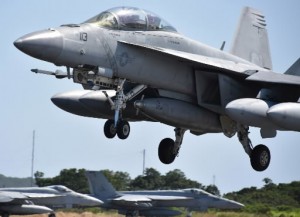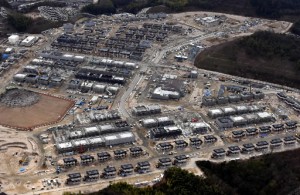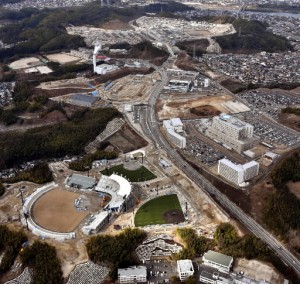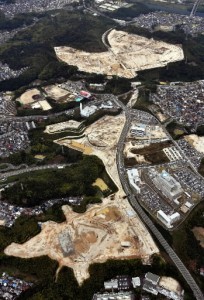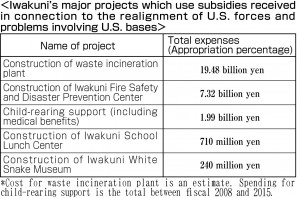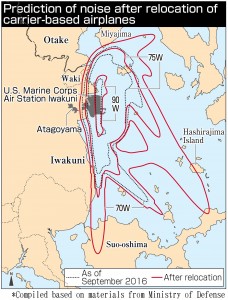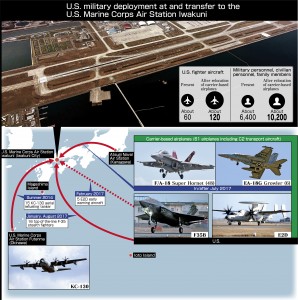U.S. military base in Iwakuni to become massive military stronghold
Mar. 7, 2017
by Kanako Noda, Staff Writer
In January, the Japanese government informed local governments about the timetable for the relocation of carrier aircraft from the Atsugi Naval Air Station, located in Kanagawa Prefecture, to the U.S. Marine Corps Air Station Iwakuni, located in Yamaguchi Prefecture. The transfer will begin this July and a total of 61 airplanes, from seven units, will move to Iwakuni by May 2018. After this transfer is completed, the Iwakuni base will be a massive military stronghold with about 120 airplanes, even more than the 100 airplanes at the Kadena Air Base in Okinawa, which is one of the biggest U.S. air bases in the Far East. At the same time, the impact of this relocation on the lives of Iwakuni residents is uncertain. The Trump administration will seek to continue strengthening the alliance between the United States and Japan, and the base in Iwakuni will become a symbol of this alliance.
Number of U.S. jet fighters in Iwakuni will double
According to the Japanese government, the E-2D early warning aircraft unit will move to Iwakuni in July or later when the nuclear-powered USS Ronald Reagan, to which the aircraft is attached, makes a port call at Yokosuka. In November, two of the four squadrons of the F/A-18 Super Hornet will be transferred to Iwakuni. The F/A-18 Super Hornet is the primary source of noise around the Atsugi base. In January 2018, the EA-18G Growler electronic warfare aircraft and C2 transport aircraft will be transferred. In May 2018, the remaining two units of F/A-18 aircraft will follow. Additionally, 1,700 service personnel, 600 civilian employees, and about 1,500 family members, totaling around 3,800 people, will move into housing units for military personnel at the Iwakuni base or units now under construction in the Atagoyama district in the city center.
According to the Chugoku Shikoku Defense Bureau, the Iwakuni base now accommodates about 60 airplanes and 6,400 service personnel and employees. As a result of this relocation (61 airplanes and 3,800 people), these numbers will double to 120 and 12,000, respectively.
For the transfer of these carrier-based airplanes, the Japanese government has spent some 423.4 billion yen (the total amount from contracts) between fiscal 2006 and 2015 on improving facilities and pursuing other projects at the Iwakuni base and in the Atagoyama area.
Five E2D aircraft, the aircraft succeeding the E2C and stationed at the Atsugi base, came to the Iwakuni base this past February as “training prior to deployment.”
What are carrier-based aircraft?
Of the nine squadrons of the Carrier Air Wing Five, which is attached to the USS Ronald Reagan, 61 airplanes from the seven units, except for two helicopter units, will be transferred to the Iwakuni base. Since the Japanese and the U.S. governments first settled on transferring 59 airplanes in 2006, some changes have been made to the types and numbers of some of the planes. Now the Japanese government estimates that the number will be 61, of which 48 are F/A-18 Super Hornets.
The aircraft carrier is homeported at the Atsugi Naval Air Station, located in Yokosuka, Kanagawa Prefecture, and is deployed on the ocean with carrier-based airplanes. It enters port at Yokosuka for inspection and maintenance roughly 200 days a year. The carrier-based planes fly to the Atsugi base around the time the carrier comes into port. The airplanes based in Atsugi fly, take off, and land many times, generating an ear-splitting noise.
According to the U.S. Navy, landing on an aircraft carrier at sea requires great accuracy and pilots must maintain their skills through regular training. Before the carrier leaves port, pilots participate in field carrier landing practice (FCLP) on Ioto (Iwo Jima) Island, about 1,200 kilometers south of mainland Tokyo. In FCLP activities, pilots have the aircraft land and take off from a simulated carrier landing deck many times. As the airplanes fly between Atsugi and Ioto Island, the noise pollution around the base becomes more serious before the aircraft carrier leaves port.
As the carrier will be transferred to Iwakuni, the Japanese government is planning to buy Mageshima Island in Kagoshima Prefecture as a candidate site for constructing a new FCLP facility. The Iwakuni base is closer to Mageshima Island than to Ioto Island.
But in January, at a meeting attended by all the members of the Iwakuni city assembly, the participants from the national government said that it will take some 10 years after the land is purchased for the facility to be completed. The planes will then make use of Ioto Island for quite some time after they are transferred to Iwakuni. The distance between Atsugi and Ioto Island is 1,190 kilometers, but the distance between Iwakuni and the island is 1,350 kilometers. The U.S. Navy says there are risks to flying this longer distance.
Aim of U.S. military realignment in Japan
In May 2006, Tokyo and Washington agreed on a road map for the realignment of U.S. military forces stationed in Japan, including the relocation of the carrier air wing squadrons to Iwakuni. The Japanese government has explained to local governments that the realignment is meant to maintain a deterrent while reducing Okinawa’s burden in hosting U.S. military bases.
This realignment reflects the U.S. intention to improve its operational readiness to cope with diverse conditions while placing importance on the Asia Pacific region. Last autumn, Lieutenant General Jerry Martinez, the Commander of U.S. Forces Japan, said that geographically the Iwakuni base is in a strategically important location and suited to handling a range of operations, stressing that the U.S.-Japan alliance will remain strong. He added that the base and the city’s residents have created strong ties that can serve as a model for other bases.
Compared to Atsugi, an area of high population density, Iwakuni provides a safer environment for training because its airstrip has been relocated to the seaside, said a senior officer of the U.S. Navy stationed in Japan. He also pointed out that it is important for U.S. forces to be able to coexist with the U.S. Marine Corps and the Japan Maritime Self-Defense Force. He also believes that Iwakuni’s proximity to North Korea and China provides an advantage in closely monitoring their military developments.
Daniel Prochazka is the commanding officer of the Carrier Airborne Early Warning Squadron 125, which operates the E2D that arrived at the Iwakuni base from the United States in February as “training before deployment.” He said that the aircraft has one of the most advanced types of airborne radar in the world and that he is proud it can contribute to strengthening the U.S.-Japan alliance.
Concerns about noise pollution
Regarding the noise level around the Atsugi base, which is located in a densely populated metropolitan area, lawsuits have been filed over the past 40 years against the Japanese government by people living in the vicinity, who have sought a ban on flights or compensation for the disturbance. In Iwakuni, the first court ruling on noise pollution around the Iwakuni base was handed out by the Yamaguchi District Court’s Iwakuni branch in October 2015. The court judged that the noise caused by U.S. military aircraft has violated the peaceful life of residents of Iwakuni, which is illegal.
In Iwakuni, as well as in Atsugi, people who live near the base have sued the Japanese government. The court ordered that a total of 558 million yen be paid for past noise damage. It also presumed that this noise pollution will grow worse after the transfer of carrier-based airplanes, indicating that the relocation of the runway to an offshore location will have only a limited effect on reducing the noise.
The noise that has been ruled illegal by the court will come to Iwakuni. There is no knowing how much noise the carrier-based aircraft will bring to Iwakuni, which is facing the sea and has different geographical features from Atsugi.
When it concluded an agreement with the U.S. government in 2006, the Japanese government issued a prediction about how the relocation of carrier-based aircraft would affect the noise level. Based on the changes in the number and the kinds of aircraft, the government renewed its prediction in January of this year.
According to the renewed noise prediction, the area where the noise level is 75 or above in weighted equivalent continuous perceived noise level (an aircraft noise index) will become larger in part of the town of Yuu than in 2006, but in total the area will be smaller. The value 75 is used as a criterion for defining areas where noise insulation work for residences will be subsidized (type 1 district). On the other hand, areas in which values are 70 or above will become larger in parts of the towns of Suo-oshima and Waki.
The renewed prediction estimates that the number of flights at the Iwakuni base will increase from 326 in 2006 to 458 a day, which is a 40 percent increase. But the total area of the type 1 districts will become 40 percent smaller from 1,600 to 650 hectares.
Some people are not convinced by the prediction, saying it does not reflect the reality of how U.S. jet fighters fly now. A citizens’ group in Hatsukaichi, which is located in the western part of Hiroshima Prefecture and is close to Iwakuni, is against the expansion and enhancement of the Iwakuni base. The group is calling on the municipal government to urge the national government to redo the prediction, claiming that jet fighters are often seen around Hatsukaichi.
Iwakuni requests for safety and security, regional promotion
The City of Iwakuni has expressed understanding and been supportive of the realignment of U.S. military forces in Japan, but has not yet clearly confirmed that it will accept the relocation of carrier-based airplanes. Because the United States has given a detailed schedule for the relocation, and the Iwakuni base has been making preparations, the city government now has to make a final judgment.
The relocation of carrier-based planes was the biggest issue in the Iwakuni mayoral election held in February 2008. Yoshihiko Fukuda, the current mayor, pledged to support the realignment plan and beat Katsusuke Ihara, the former mayor who was against the relocation, by 1,782 votes. Shortly after assuming the post, Mr. Fukuda submitted a 43-point request to the national government on the assumption that the city would accept the carrier-based airplanes in the future. The 43 measures, which are meant to ensure the safety and security of residents and regional promotion, include increasing designated areas for subsidizing noise insulation work for residences and reviewing the Japan-U.S. Status of Forces Agreement. The municipal government is still discussing these measures with the national government.
Mayor Fukuda said that the decision to accept the relocation should be made after the discussions, and the degrees of achievement of the city’s demands should be used as criteria. According to the city government, 34, or 80 percent, of the 43 items have either been achieved or are in progress.
Since the turn of the year, and the relocation of the carrier-based planes has become more of a reality, the discussions between the city and the national government have evolved into negotiations regarding the conditions for this change. On January 20, when the national government explained the relocation schedule to the city and prefectural governments, Mayor Fukuda demanded political moves by the national government. He referred to specific names of regional promotion projects and pressed for their implementation to Nobuo Kishi, the parliamentary senior vice-minister for foreign affairs, and others.
Only a week after the meeting, the national government referred to extending the Iwakuni South Bypass in a conference attended by all the members of the city assembly. The national government side also made a clear statement that it would take budgetary measures for making school lunch free of charge and installing outdoor security lights, which are measures newly demanded by Mayor Fukuda. On February 5, Yoshihide Suga, the chief cabinet secretary, met with Mayor Fukuda and Tsugumasa Muraoka, the governor of Yamaguchi Prefecture. Mr. Suga said that the national government will do its utmost to ensure safety and prevent noise while implementing the regional promotion measures in a tangible way.
Since fiscal 2008, Iwakuni and surrounding municipalities have been receiving grants directly from the national government in relation to the realignment of U.S. forces. Since the relocation will take until around May 2018, the subsidies will be provided until fiscal 2022. The total amount of the grants the city received up to fiscal 2015 was 1.812 billion yen. The city estimates that it can receive a total amount of 20.1 billion yen by fiscal 2022. But it has no clear idea whether or not the period will be extended or the payments will be increased as the city government has been demanding.
As for subsidies given to prefectural governments that will have to bear a heavier burden because of the realignment of U.S. forces in Japan, the Japanese government has decided to extend the period by three years from the original fiscal 2016. In the budget for fiscal 2017, 2.01 billion yen, an increase of 10 million yen from a year earlier, will be allocated for this and Yamaguchi Prefecture will receive all of the greater amount.
The prefectural and municipal governments view the relocation of the U.S. Marine Corps Air Station Futenma, located in Ginowan, Okinawa Prefecture, as the basis for the realignment of U.S. forces in Japan and is a prerequisite for the relocation of carrier-based aircraft. They are closely watching the moves surrounding this issue. This is because if Okinawa’s burden is not eased and Iwakuni’s burden becomes heavier, it does not serve the purpose of the realignment. In the conference of all the members of the Iwakuni municipal assembly held on January 27, Hiroyuki Miyazawa, the parliamentary secretary for defense, said, “The Supreme Court ruling (on the relocation of Futenma issued in December 2016) will help push the relocation forward, and provided more insight.”
Iwakuni’s major projects which use subsidies received in connection to the realignment of U.S. forces and problems involving U.S. bases
Name of project
Total cost (Appropriation percentage)
Construction of waste incineration plant
9.48 billion yen (75%)
Construction of Iwakuni Fire Safety and Disaster Prevention Center
7.32 billion yen (75%)
Child-rearing support (including medical benefits)
1.99 billion yen (100%)
Construction of Iwakuni School Lunch Center
710 million yen (95%)
Construction of Iwakuni White Snake Museum
240 million yen (90%)
*Cost for waste incineration plant is an estimate. Spending for child-rearing support is the total between fiscal 2008 and 2015.
Facilities for U.S. military personnel under construction in Atagoyama district
In the Atagoyama district, located about three kilometers to the west of the Iwakuni base, the Chugoku Shikoku Defense Bureau is constructing facilities for U.S. forces to prepare for the relocation of carrier-based aircraft. One area is for housing to accommodate military personnel and their families (28 hectares) and the other area is for sports facilities (16 hectares). The city government has acknowledged that the construction of these facilities is “preparation” for the relocation.
According to the bureau, the completion of the baseball field, which was the first goal for the construction work, will be delayed to the end of July instead of the end of March as originally planned. Regarding the reason for this delay, the bureau explained that the factory that produces the concrete parts designed to support the stands for spectators was damaged by the strong earthquakes that rocked Kumamoto last April and this has resulted in delays in procurement and construction.
Of the 262 houses for military personnel and their families, 131 will be completed by the end of May. By the end of July, the remaining houses and the baseball field will be finished. The community center and the athletic field will be completed by the end of October 2017 and the end of February 2018, respectively.
Both U.S. service members and Iwakuni citizens will have access to the sports facility area. In principle, people will have free access to the area while the gate is open without having to show their identification cards. The city and national governments, along with the U.S. side, are discussing such details as how much the fees will be and how reservations can be made.
Major events involving the relocation of carrier-based airplanes to Iwakuni
May 2006
The Japanese and U.S. governments agree on the final report concerning the realignment of U.S. forces in Japan, including the relocation of the carrier air wing from the Atsugi Air Facility.
February 2008
Yoshihiko Fukuda, who is supported by those who favor accepting the relocation, is elected Iwakuni mayor for the first time.
October 2008
Mayor Fukuda submits requests to the national government calling for measures to ensure safety and security as well as maintain the Maritime Self-Defense Force squadrons in Iwakuni.
March 2009
Mayor Fukuda calls on the national government to support the city’s regional promotion measures including improving a network of major roads.
May 2010
Work begins on the construction of a new runway, one kilometer off the coast, for the U.S. Marine Corps Air Station Iwakuni.
March 2012
The Yamaguchi Prefectural Housing Cooperation and the national government sign a land sales contract concerning the site of the former Atagoyama area development project.
December 2012
Iwakuni Kintaikyo Airport opens as the second airport for joint military-civilian use in Japan.
January 2013
The national government informs the Yamaguchi prefectural and Iwakuni municipal governments that the relocation of carrier-based aircraft will be delayed by three years to 2017.
December 2013
The prefectural and city governments inform the national government that they will accept the relocation of KC-130 aerial refueling planes to Iwakuni.
May 2014
Construction begins on facilities for U.S. military forces in the Atagoyama district.
August 2014
The Iwakuni base announces that the relocation of 15 KC-130 aerial refueling planes from the U.S. Marine Corps Air Station Futenma (Okinawa) has been completed.
January 2017
U.S. Naval Forces Japan announces that the relocation of the carrier air wing will start in the latter half of 2017.
The national government informs the prefecture and the city of such details as the time and the number of airplanes.
The municipal assembly holds a conference attended by all its members.
February 2017
Five E2D carrier-based airplanes arrive at the Iwakuni base as “training before deployment.”
(Originally published on March 7, 2017)
In January, the Japanese government informed local governments about the timetable for the relocation of carrier aircraft from the Atsugi Naval Air Station, located in Kanagawa Prefecture, to the U.S. Marine Corps Air Station Iwakuni, located in Yamaguchi Prefecture. The transfer will begin this July and a total of 61 airplanes, from seven units, will move to Iwakuni by May 2018. After this transfer is completed, the Iwakuni base will be a massive military stronghold with about 120 airplanes, even more than the 100 airplanes at the Kadena Air Base in Okinawa, which is one of the biggest U.S. air bases in the Far East. At the same time, the impact of this relocation on the lives of Iwakuni residents is uncertain. The Trump administration will seek to continue strengthening the alliance between the United States and Japan, and the base in Iwakuni will become a symbol of this alliance.
Number of U.S. jet fighters in Iwakuni will double
According to the Japanese government, the E-2D early warning aircraft unit will move to Iwakuni in July or later when the nuclear-powered USS Ronald Reagan, to which the aircraft is attached, makes a port call at Yokosuka. In November, two of the four squadrons of the F/A-18 Super Hornet will be transferred to Iwakuni. The F/A-18 Super Hornet is the primary source of noise around the Atsugi base. In January 2018, the EA-18G Growler electronic warfare aircraft and C2 transport aircraft will be transferred. In May 2018, the remaining two units of F/A-18 aircraft will follow. Additionally, 1,700 service personnel, 600 civilian employees, and about 1,500 family members, totaling around 3,800 people, will move into housing units for military personnel at the Iwakuni base or units now under construction in the Atagoyama district in the city center.
According to the Chugoku Shikoku Defense Bureau, the Iwakuni base now accommodates about 60 airplanes and 6,400 service personnel and employees. As a result of this relocation (61 airplanes and 3,800 people), these numbers will double to 120 and 12,000, respectively.
For the transfer of these carrier-based airplanes, the Japanese government has spent some 423.4 billion yen (the total amount from contracts) between fiscal 2006 and 2015 on improving facilities and pursuing other projects at the Iwakuni base and in the Atagoyama area.
Five E2D aircraft, the aircraft succeeding the E2C and stationed at the Atsugi base, came to the Iwakuni base this past February as “training prior to deployment.”
What are carrier-based aircraft?
Of the nine squadrons of the Carrier Air Wing Five, which is attached to the USS Ronald Reagan, 61 airplanes from the seven units, except for two helicopter units, will be transferred to the Iwakuni base. Since the Japanese and the U.S. governments first settled on transferring 59 airplanes in 2006, some changes have been made to the types and numbers of some of the planes. Now the Japanese government estimates that the number will be 61, of which 48 are F/A-18 Super Hornets.
The aircraft carrier is homeported at the Atsugi Naval Air Station, located in Yokosuka, Kanagawa Prefecture, and is deployed on the ocean with carrier-based airplanes. It enters port at Yokosuka for inspection and maintenance roughly 200 days a year. The carrier-based planes fly to the Atsugi base around the time the carrier comes into port. The airplanes based in Atsugi fly, take off, and land many times, generating an ear-splitting noise.
According to the U.S. Navy, landing on an aircraft carrier at sea requires great accuracy and pilots must maintain their skills through regular training. Before the carrier leaves port, pilots participate in field carrier landing practice (FCLP) on Ioto (Iwo Jima) Island, about 1,200 kilometers south of mainland Tokyo. In FCLP activities, pilots have the aircraft land and take off from a simulated carrier landing deck many times. As the airplanes fly between Atsugi and Ioto Island, the noise pollution around the base becomes more serious before the aircraft carrier leaves port.
As the carrier will be transferred to Iwakuni, the Japanese government is planning to buy Mageshima Island in Kagoshima Prefecture as a candidate site for constructing a new FCLP facility. The Iwakuni base is closer to Mageshima Island than to Ioto Island.
But in January, at a meeting attended by all the members of the Iwakuni city assembly, the participants from the national government said that it will take some 10 years after the land is purchased for the facility to be completed. The planes will then make use of Ioto Island for quite some time after they are transferred to Iwakuni. The distance between Atsugi and Ioto Island is 1,190 kilometers, but the distance between Iwakuni and the island is 1,350 kilometers. The U.S. Navy says there are risks to flying this longer distance.
Aim of U.S. military realignment in Japan
In May 2006, Tokyo and Washington agreed on a road map for the realignment of U.S. military forces stationed in Japan, including the relocation of the carrier air wing squadrons to Iwakuni. The Japanese government has explained to local governments that the realignment is meant to maintain a deterrent while reducing Okinawa’s burden in hosting U.S. military bases.
This realignment reflects the U.S. intention to improve its operational readiness to cope with diverse conditions while placing importance on the Asia Pacific region. Last autumn, Lieutenant General Jerry Martinez, the Commander of U.S. Forces Japan, said that geographically the Iwakuni base is in a strategically important location and suited to handling a range of operations, stressing that the U.S.-Japan alliance will remain strong. He added that the base and the city’s residents have created strong ties that can serve as a model for other bases.
Compared to Atsugi, an area of high population density, Iwakuni provides a safer environment for training because its airstrip has been relocated to the seaside, said a senior officer of the U.S. Navy stationed in Japan. He also pointed out that it is important for U.S. forces to be able to coexist with the U.S. Marine Corps and the Japan Maritime Self-Defense Force. He also believes that Iwakuni’s proximity to North Korea and China provides an advantage in closely monitoring their military developments.
Daniel Prochazka is the commanding officer of the Carrier Airborne Early Warning Squadron 125, which operates the E2D that arrived at the Iwakuni base from the United States in February as “training before deployment.” He said that the aircraft has one of the most advanced types of airborne radar in the world and that he is proud it can contribute to strengthening the U.S.-Japan alliance.
Concerns about noise pollution
Regarding the noise level around the Atsugi base, which is located in a densely populated metropolitan area, lawsuits have been filed over the past 40 years against the Japanese government by people living in the vicinity, who have sought a ban on flights or compensation for the disturbance. In Iwakuni, the first court ruling on noise pollution around the Iwakuni base was handed out by the Yamaguchi District Court’s Iwakuni branch in October 2015. The court judged that the noise caused by U.S. military aircraft has violated the peaceful life of residents of Iwakuni, which is illegal.
In Iwakuni, as well as in Atsugi, people who live near the base have sued the Japanese government. The court ordered that a total of 558 million yen be paid for past noise damage. It also presumed that this noise pollution will grow worse after the transfer of carrier-based airplanes, indicating that the relocation of the runway to an offshore location will have only a limited effect on reducing the noise.
The noise that has been ruled illegal by the court will come to Iwakuni. There is no knowing how much noise the carrier-based aircraft will bring to Iwakuni, which is facing the sea and has different geographical features from Atsugi.
When it concluded an agreement with the U.S. government in 2006, the Japanese government issued a prediction about how the relocation of carrier-based aircraft would affect the noise level. Based on the changes in the number and the kinds of aircraft, the government renewed its prediction in January of this year.
According to the renewed noise prediction, the area where the noise level is 75 or above in weighted equivalent continuous perceived noise level (an aircraft noise index) will become larger in part of the town of Yuu than in 2006, but in total the area will be smaller. The value 75 is used as a criterion for defining areas where noise insulation work for residences will be subsidized (type 1 district). On the other hand, areas in which values are 70 or above will become larger in parts of the towns of Suo-oshima and Waki.
The renewed prediction estimates that the number of flights at the Iwakuni base will increase from 326 in 2006 to 458 a day, which is a 40 percent increase. But the total area of the type 1 districts will become 40 percent smaller from 1,600 to 650 hectares.
Some people are not convinced by the prediction, saying it does not reflect the reality of how U.S. jet fighters fly now. A citizens’ group in Hatsukaichi, which is located in the western part of Hiroshima Prefecture and is close to Iwakuni, is against the expansion and enhancement of the Iwakuni base. The group is calling on the municipal government to urge the national government to redo the prediction, claiming that jet fighters are often seen around Hatsukaichi.
Iwakuni requests for safety and security, regional promotion
The City of Iwakuni has expressed understanding and been supportive of the realignment of U.S. military forces in Japan, but has not yet clearly confirmed that it will accept the relocation of carrier-based airplanes. Because the United States has given a detailed schedule for the relocation, and the Iwakuni base has been making preparations, the city government now has to make a final judgment.
The relocation of carrier-based planes was the biggest issue in the Iwakuni mayoral election held in February 2008. Yoshihiko Fukuda, the current mayor, pledged to support the realignment plan and beat Katsusuke Ihara, the former mayor who was against the relocation, by 1,782 votes. Shortly after assuming the post, Mr. Fukuda submitted a 43-point request to the national government on the assumption that the city would accept the carrier-based airplanes in the future. The 43 measures, which are meant to ensure the safety and security of residents and regional promotion, include increasing designated areas for subsidizing noise insulation work for residences and reviewing the Japan-U.S. Status of Forces Agreement. The municipal government is still discussing these measures with the national government.
Mayor Fukuda said that the decision to accept the relocation should be made after the discussions, and the degrees of achievement of the city’s demands should be used as criteria. According to the city government, 34, or 80 percent, of the 43 items have either been achieved or are in progress.
Since the turn of the year, and the relocation of the carrier-based planes has become more of a reality, the discussions between the city and the national government have evolved into negotiations regarding the conditions for this change. On January 20, when the national government explained the relocation schedule to the city and prefectural governments, Mayor Fukuda demanded political moves by the national government. He referred to specific names of regional promotion projects and pressed for their implementation to Nobuo Kishi, the parliamentary senior vice-minister for foreign affairs, and others.
Only a week after the meeting, the national government referred to extending the Iwakuni South Bypass in a conference attended by all the members of the city assembly. The national government side also made a clear statement that it would take budgetary measures for making school lunch free of charge and installing outdoor security lights, which are measures newly demanded by Mayor Fukuda. On February 5, Yoshihide Suga, the chief cabinet secretary, met with Mayor Fukuda and Tsugumasa Muraoka, the governor of Yamaguchi Prefecture. Mr. Suga said that the national government will do its utmost to ensure safety and prevent noise while implementing the regional promotion measures in a tangible way.
Since fiscal 2008, Iwakuni and surrounding municipalities have been receiving grants directly from the national government in relation to the realignment of U.S. forces. Since the relocation will take until around May 2018, the subsidies will be provided until fiscal 2022. The total amount of the grants the city received up to fiscal 2015 was 1.812 billion yen. The city estimates that it can receive a total amount of 20.1 billion yen by fiscal 2022. But it has no clear idea whether or not the period will be extended or the payments will be increased as the city government has been demanding.
As for subsidies given to prefectural governments that will have to bear a heavier burden because of the realignment of U.S. forces in Japan, the Japanese government has decided to extend the period by three years from the original fiscal 2016. In the budget for fiscal 2017, 2.01 billion yen, an increase of 10 million yen from a year earlier, will be allocated for this and Yamaguchi Prefecture will receive all of the greater amount.
The prefectural and municipal governments view the relocation of the U.S. Marine Corps Air Station Futenma, located in Ginowan, Okinawa Prefecture, as the basis for the realignment of U.S. forces in Japan and is a prerequisite for the relocation of carrier-based aircraft. They are closely watching the moves surrounding this issue. This is because if Okinawa’s burden is not eased and Iwakuni’s burden becomes heavier, it does not serve the purpose of the realignment. In the conference of all the members of the Iwakuni municipal assembly held on January 27, Hiroyuki Miyazawa, the parliamentary secretary for defense, said, “The Supreme Court ruling (on the relocation of Futenma issued in December 2016) will help push the relocation forward, and provided more insight.”
Iwakuni’s major projects which use subsidies received in connection to the realignment of U.S. forces and problems involving U.S. bases
Name of project
Total cost (Appropriation percentage)
Construction of waste incineration plant
9.48 billion yen (75%)
Construction of Iwakuni Fire Safety and Disaster Prevention Center
7.32 billion yen (75%)
Child-rearing support (including medical benefits)
1.99 billion yen (100%)
Construction of Iwakuni School Lunch Center
710 million yen (95%)
Construction of Iwakuni White Snake Museum
240 million yen (90%)
*Cost for waste incineration plant is an estimate. Spending for child-rearing support is the total between fiscal 2008 and 2015.
Facilities for U.S. military personnel under construction in Atagoyama district
In the Atagoyama district, located about three kilometers to the west of the Iwakuni base, the Chugoku Shikoku Defense Bureau is constructing facilities for U.S. forces to prepare for the relocation of carrier-based aircraft. One area is for housing to accommodate military personnel and their families (28 hectares) and the other area is for sports facilities (16 hectares). The city government has acknowledged that the construction of these facilities is “preparation” for the relocation.
According to the bureau, the completion of the baseball field, which was the first goal for the construction work, will be delayed to the end of July instead of the end of March as originally planned. Regarding the reason for this delay, the bureau explained that the factory that produces the concrete parts designed to support the stands for spectators was damaged by the strong earthquakes that rocked Kumamoto last April and this has resulted in delays in procurement and construction.
Of the 262 houses for military personnel and their families, 131 will be completed by the end of May. By the end of July, the remaining houses and the baseball field will be finished. The community center and the athletic field will be completed by the end of October 2017 and the end of February 2018, respectively.
Both U.S. service members and Iwakuni citizens will have access to the sports facility area. In principle, people will have free access to the area while the gate is open without having to show their identification cards. The city and national governments, along with the U.S. side, are discussing such details as how much the fees will be and how reservations can be made.
Major events involving the relocation of carrier-based airplanes to Iwakuni
May 2006
The Japanese and U.S. governments agree on the final report concerning the realignment of U.S. forces in Japan, including the relocation of the carrier air wing from the Atsugi Air Facility.
February 2008
Yoshihiko Fukuda, who is supported by those who favor accepting the relocation, is elected Iwakuni mayor for the first time.
October 2008
Mayor Fukuda submits requests to the national government calling for measures to ensure safety and security as well as maintain the Maritime Self-Defense Force squadrons in Iwakuni.
March 2009
Mayor Fukuda calls on the national government to support the city’s regional promotion measures including improving a network of major roads.
May 2010
Work begins on the construction of a new runway, one kilometer off the coast, for the U.S. Marine Corps Air Station Iwakuni.
March 2012
The Yamaguchi Prefectural Housing Cooperation and the national government sign a land sales contract concerning the site of the former Atagoyama area development project.
December 2012
Iwakuni Kintaikyo Airport opens as the second airport for joint military-civilian use in Japan.
January 2013
The national government informs the Yamaguchi prefectural and Iwakuni municipal governments that the relocation of carrier-based aircraft will be delayed by three years to 2017.
December 2013
The prefectural and city governments inform the national government that they will accept the relocation of KC-130 aerial refueling planes to Iwakuni.
May 2014
Construction begins on facilities for U.S. military forces in the Atagoyama district.
August 2014
The Iwakuni base announces that the relocation of 15 KC-130 aerial refueling planes from the U.S. Marine Corps Air Station Futenma (Okinawa) has been completed.
January 2017
U.S. Naval Forces Japan announces that the relocation of the carrier air wing will start in the latter half of 2017.
The national government informs the prefecture and the city of such details as the time and the number of airplanes.
The municipal assembly holds a conference attended by all its members.
February 2017
Five E2D carrier-based airplanes arrive at the Iwakuni base as “training before deployment.”
(Originally published on March 7, 2017)

